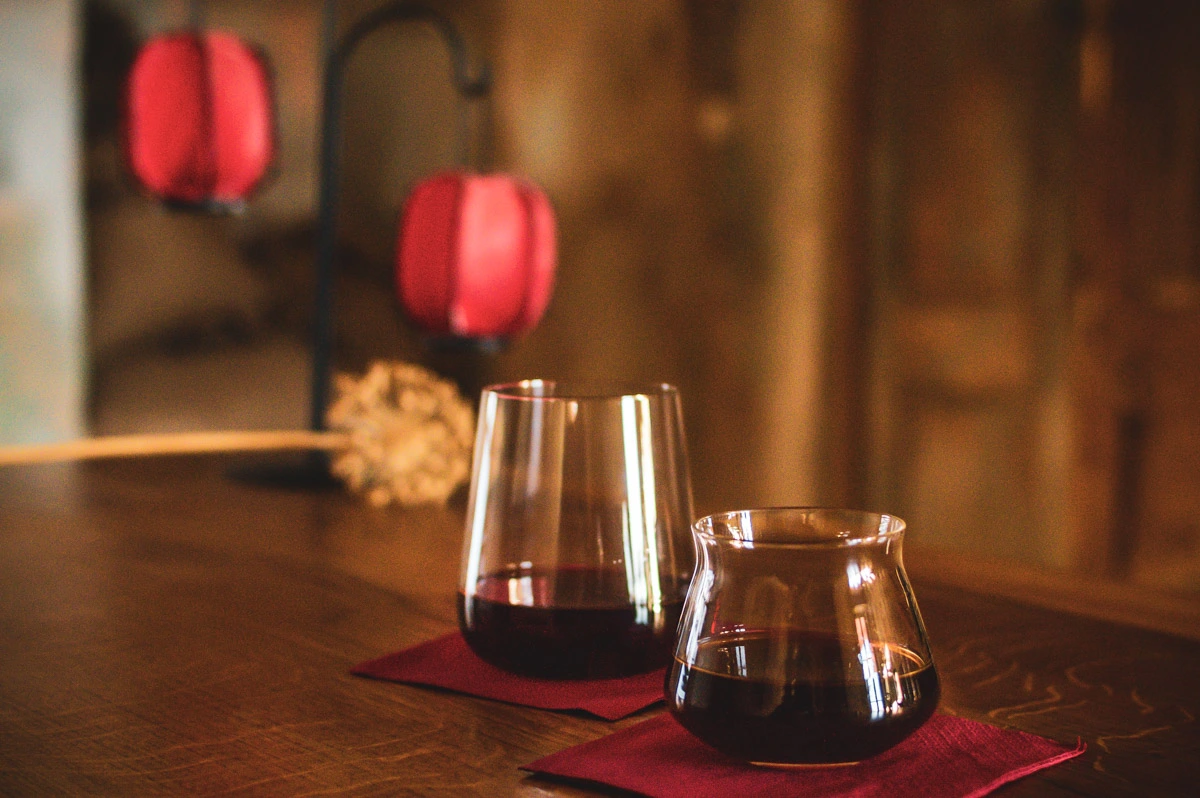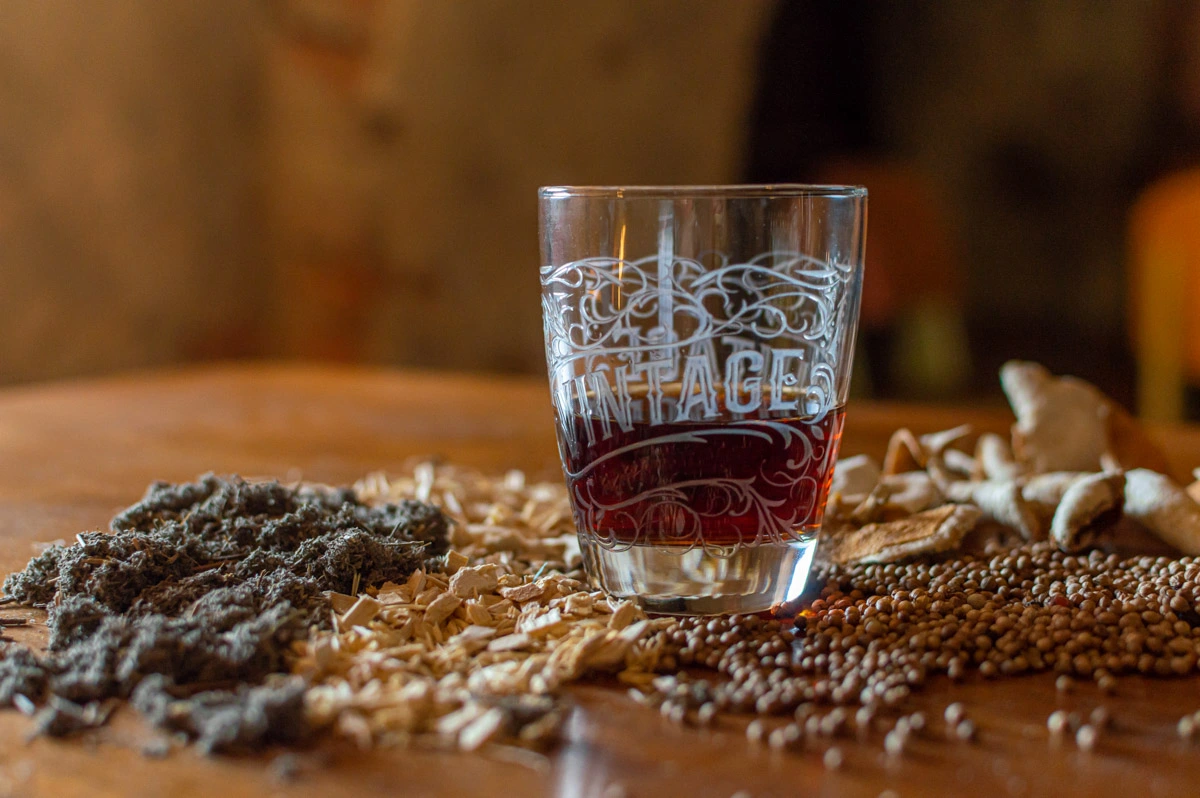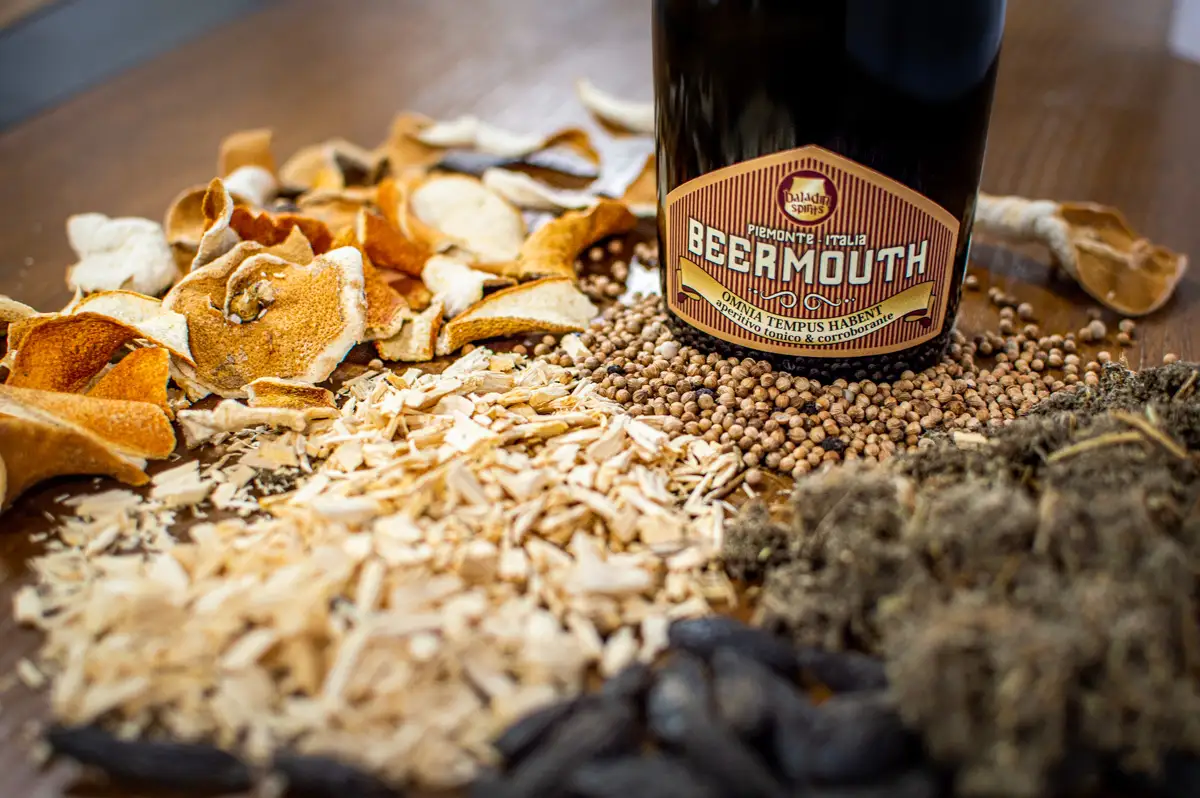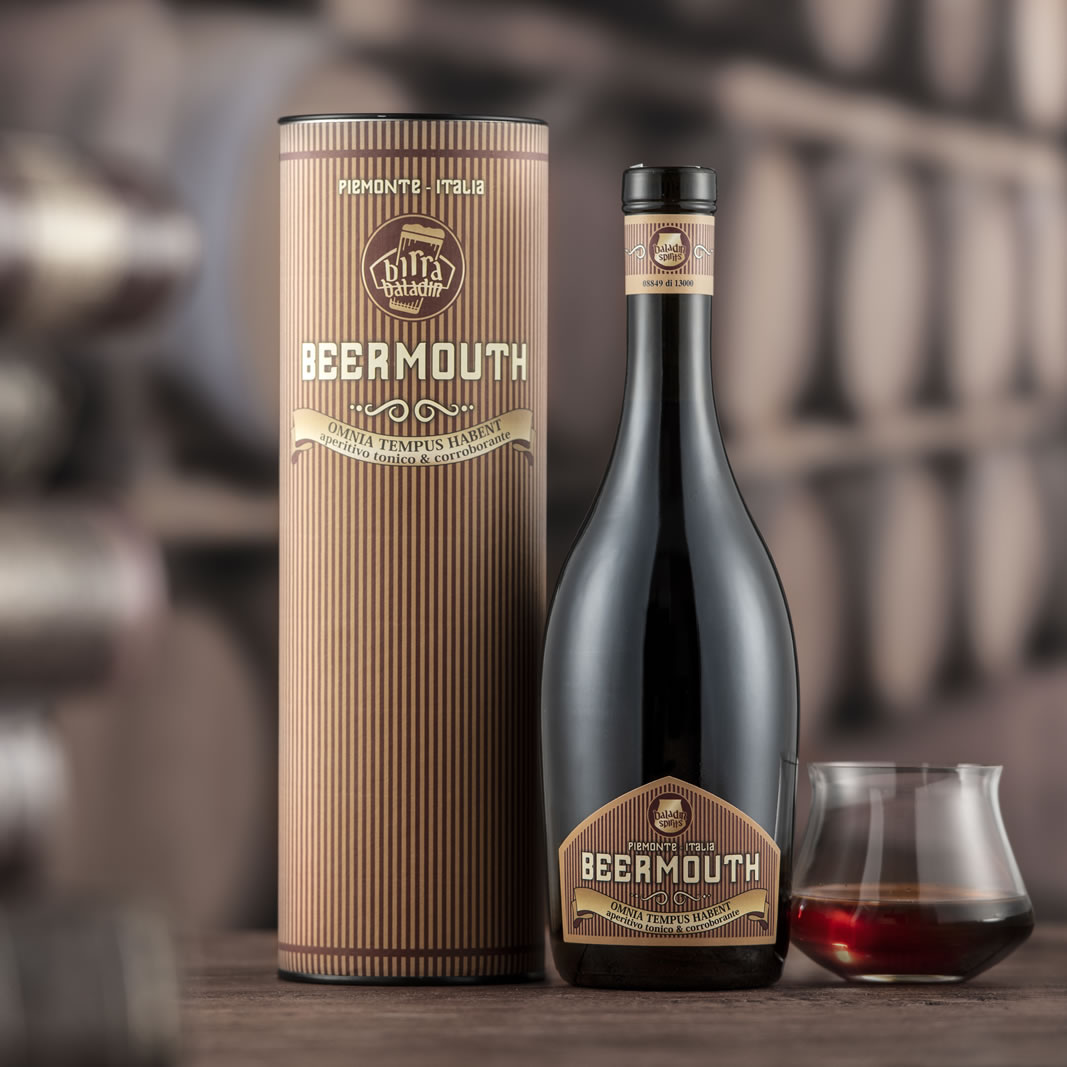- The origins of vermouth (and the idea of experimenting with beer)
- The ingredients of vermouth: flowers, fruit, roots, and wine. What about beer?
- Vermouth and Beermouth in the art of mixology
- The food to enjoy with a glass of vermouth and Beermouth
- 13 botanicals, 1 innovative ingredient: the birth of Baladin Beermouth
- What does Baladin Beermouth taste like? Innovation inspired by the tradition of vermouth
Contents

The origins of vermouth (and the idea of experimenting with beer)
The origins of vermouth (and the idea of experimenting with beer)
It just takes one word to evoke colors, scents and especially tastes that, over time, have become inimitable (and a flagship of Italian production). We are talking about vermouth, a delicacy made from grapes that come from Piedmont. In the 18th century, local wines - such as Moscato di Canelli or white wines from around Alessandria, in the Gavi and Tortona region - start to be combined with a rich variety of aromatic herbs that were traditionally gathered and grown in the same areas, such as mugwort, yarrow, chamomile, hyssop, savory, marjoram, sage, Sclarea sage, elder and thyme, as well as spices such as cinnamon, cardamom, cloves, coriander, nutmeg, vanilla, saffron and many others. A tradition that goes back a long way and owes its origin to the medicinal wines that were already used by the ancients, and where the alcohol served as a solvent for herbs and medical preparations.
Between 1700 and 1800, in Piedmont (and especially in Turin), the preparation of this flavored wine becomes a true art, with entire families of vermouth makers producing and selling this inimitable product throughout Europe and making it famous beyond national borders. Since then, experimentation has never stopped. Especially in more recent times, it has inspired a growing number of experts in the sector to think of possible interpretations and include the most disparate ingredients in their recipes: from the "simplest" variations with aromatic herbs to the decision to look at tradition to (re)start from a new base, such as beer. The result is a product that takes its cue from the past but achieves new (and unexpected) results.
The ingredients of vermouth: flowers, fruit, roots, and wine. What about beer?
Many trace the recipe for the commonly known vermouth back to the creativity of Antonio Benedetto Carpano, shop boy in a liquor and wine store. The recipe involves the use of fortified wine and a complex mix of herbs and spices, with mugwort being mandatory.
The product specification for the geographical indication «Vermut di Torino»/«Vermouth di Torino» was published in 2017. It accurately specifies the characteristics of the product, its essential ingredients and their origin. Among other things, it states that: "The combination of ingredients and production techniques have been handed down from one generation to the next, with distinctive flavors and features found in the recipes that each company jealously keeps. There has been an evolution of processing techniques. New techniques stand side by side with older ones and their coexistence continues to preserve and promote the traditional production". This evolution has become a bit of a revolution. In recent years, it has inspired some of the most imaginative producers to rethink this world of ingredients and scents of the past using a contemporary approach and thinking outside the traditional box of vermouth.
These continuous experiments are what sparked the idea of drawing inspiration from this ancient tradition and bringing it to the world of fermented wort made with barley malt, water, hops and yeast. Beer, that is. The result is not a vermouth, but rather an innovative product that is certainly “different” from the flavored wines we have been talking about , but which looks to the past to offer new, unprecedented tastes.

Vermouth e Beermouth in the art of mixology
It goes without saying that a product as versatile as Vermouth, used for constantly new and extreme experiments and the origin of the brand new drink known as Beermouth, has attracted the interest of mixology: a world of professionals in the preparation of cocktails and in the study of distillates and spirits who create innovative drinks with increasingly refined techniques and whose strong point is “alchemical” experimentation. They prepare the most daring and delicious beverage combinations for the drinkers of today and tomorrow.
Some examples? Let’s start from vermouth. According to Dennis Zoppi, one of the most famous Italian mixology artists in the world, the rebirth of this product and its ancient flavor in the recipes of the most contemporary mixologists has a very precise reason: its low alcohol content. Several cocktails have been created starting from the distillate from Piedmont: in addition to the most renowned and most traditional ones are Negroni (including the “sbagliato” - literally “wrong” - version) and Manhattan, both made with red vermouth. More innovative, yet simple cocktails are, for instance white vermouth and tonic, very pleasant and contemporary especially if served with a slice of orange: “Why not build a cocktail starting from a more aromatic and less alcoholic drink?” - wondered Dennis. “Vermouth, with its rich aromas and low alcohol content, is perfect”.
Talking about being creative, why not use a bit of Beermouth and give your cocktail that little oomph that you wouldn’t expect? Dennis Zoppi, one of Beermouth’s fathers, is also the author of Beermouth and Tonic (with a grapefruit garnish), Popolare, where Beermouth is combined with Bitter Campari and Pop Baladin beer. He has also reinterpreted great classics such as Spritz and the above mentioned Manhattan, replacing the most aromatic ingredients with Beermouth.
Beermouth & Tonic: a easy recipe to fall in love with
Ice Q.S. - 1/3 of Beermouth - 2/3 of Baladin Hay Tonic Water






The food to enjoy with a glass of vermouth and Beermouth
More than just cocktails. Thanks to their taste peculiarities, vermouth and Beermouth, where the wine base with added herbs goes well with a variety of different dishes, are perfect even for an entire menu, whether it is designed for meat lovers or vegetarians. Some examples? Good pairings range from classic pub grub - burgers, fries and sauces - to raw seafood (preferably with white Vermouth); from dairy products (pungent cheeses such as goat's milk or blue cheeses are ideal) to desserts, especially with candied fruit (orange peel dipped in chocolate or leavened products such as colomba and panettone).
And what about Beermouth? It is the great protagonist of one of Italians’ favorite times of the day: the “aperitivo” From classic snacks such as nuts and olives, to more experimental dishes. None of the ingredients of this Italian ritual can resist Beermouth’s charm Dennis Zoppi can confirm it: “In our pairings - continues Dennis - we particularly like pop corns, flavored with Parmesan shavings, dehydrated lime zest, or paprika. Or try more unusual combinations, such as truffle”.
Those who want to pair Beermouth with the more substantial courses of a dinner can do so by taking a few precautions. When dessert time comes, for instance, you can taste it on its own or mix it. In the first case, go for a good baked dessert or tropical fruits, such as fresh mango and coconut, to offset its more bitter notes. Or finish off your dinner with a shakerato ice coffee with Beermouth”.
"Drink and Food" pairing during the Beermouth Night Presentation






Beermouth: reinterpretaing tradition through beer
13 botanicals, 1 innovative ingredient: the birth of Baladin Beermouth
We have talked about vermouth, but now the time has come to reveal what Beermouth is. It is an innovative, 100% Baladin product. It takes inspiration from tradition, but thanks to the ingenuity of its creators (Teo Musso, he above mentioned Dennis Zoppi and Giacomo Donadio) it combines 13 traditional botanicals with beer. Not just any beer, of course, but one of the most renowned in the Baladin range: Xyauyù.
“The motivation to act - say Teo in an interview - came from an amazing encounter with Dennis Zoppi. That night, he was transforming our Baladin Metodo Classico beer into a beer cocktail”. It was 2016. Since then, the two (and Giacomo Donadio, who was also there that night) have never stopped thinking, refining and then making something that had never existed before and that honors the products of Piedmont thanks to new processing techniques. Baladin Beermouth is made with two innovative extraction techniques used with the 13 botanicals included in the recipe: ultrasounds and low-temperature vacuum distillation, two alternative methods which preserve the fragrant aromas.


What does Baladin Beermouth taste like? Innovation inspired by the tradition of vermouth
As one may expect, the tasting of Baladin Beermouth - an unprecedented product in the world of spirits - is accompanied by an equally innovative instrument designed especially for this new drink: Teku Spirits, with the same shape of the beer tasting glass by the same name (wider bottom and a narrower top), but no stem. The proportions are slightly different, with a width/height ratio that favors the former. Its goal? Giving anyone who uses it the chance to unleash the full aromatic potential of the Beermouth, so that it can be fully appreciated with the nose even before it is tasted
Once you start sipping it, the first flavors that are perceived come from the herbs that have made Piedmont's traditional aromatic wine famous in Italy and the world: mugwort, gentian, licorice root and a hint of fresh horseradish. Malty aromas follow and take center stage, marking the difference with vermouth. The tasting experience ends with an inevitable citrus note, and a persistent and pleasantly acidic finish.


